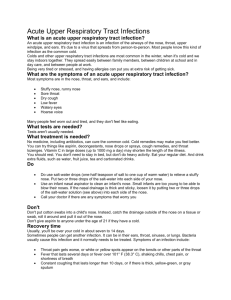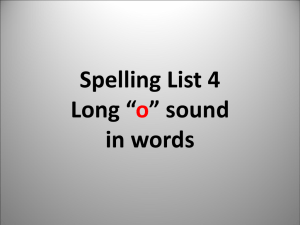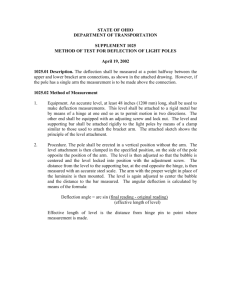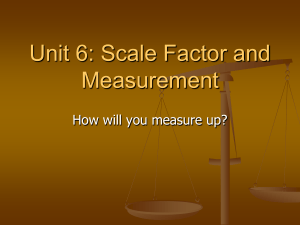208
advertisement
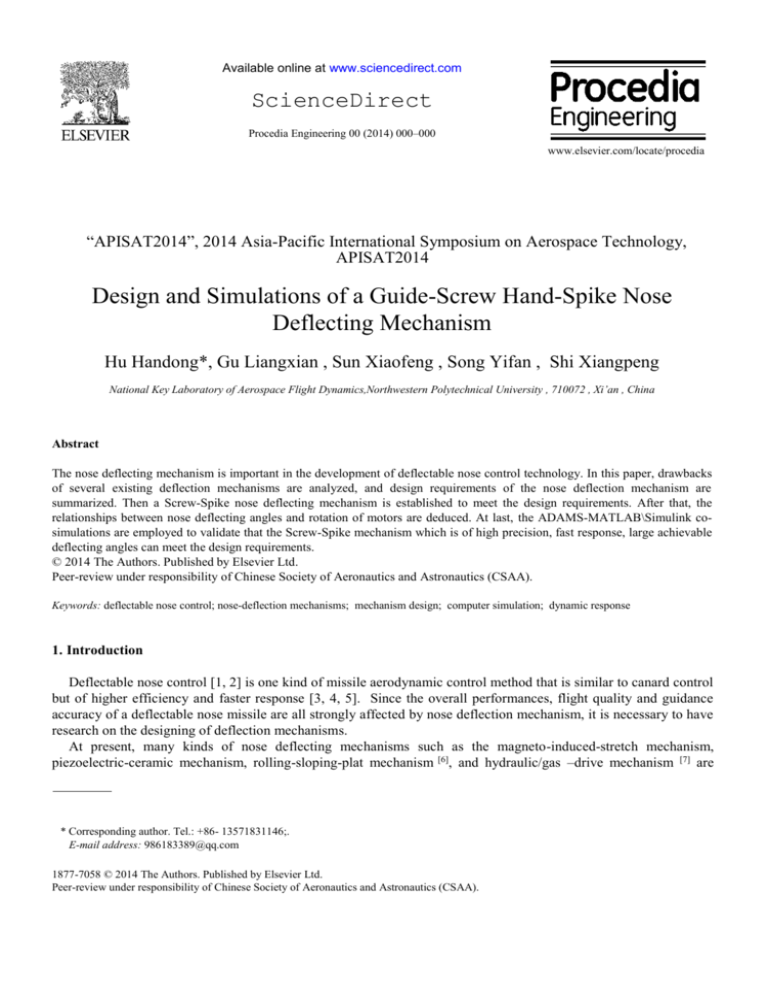
Available online at www.sciencedirect.com ScienceDirect Procedia Engineering 00 (2014) 000–000 www.elsevier.com/locate/procedia “APISAT2014”, 2014 Asia-Pacific International Symposium on Aerospace Technology, APISAT2014 Design and Simulations of a Guide-Screw Hand-Spike Nose Deflecting Mechanism Hu Handong*, Gu Liangxian , Sun Xiaofeng , Song Yifan , Shi Xiangpeng National Key Laboratory of Aerospace Flight Dynamics,Northwestern Polytechnical University , 710072 , Xi’an , China Abstract The nose deflecting mechanism is important in the development of deflectable nose control technology. In this paper, drawbacks of several existing deflection mechanisms are analyzed, and design requirements of the nose deflection mechanism are summarized. Then a Screw-Spike nose deflecting mechanism is established to meet the design requirements. After that, the relationships between nose deflecting angles and rotation of motors are deduced. At last, the ADAMS-MATLAB\Simulink cosimulations are employed to validate that the Screw-Spike mechanism which is of high precision, fast response, large achievable deflecting angles can meet the design requirements. © 2014 The Authors. Published by Elsevier Ltd. Peer-review under responsibility of Chinese Society of Aeronautics and Astronautics (CSAA). Keywords: deflectable nose control; nose-deflection mechanisms; mechanism design; computer simulation; dynamic response 1. Introduction Deflectable nose control [1, 2] is one kind of missile aerodynamic control method that is similar to canard control but of higher efficiency and faster response [3, 4, 5]. Since the overall performances, flight quality and guidance accuracy of a deflectable nose missile are all strongly affected by nose deflection mechanism, it is necessary to have research on the designing of deflection mechanisms. At present, many kinds of nose deflecting mechanisms such as the magneto-induced-stretch mechanism, piezoelectric-ceramic mechanism, rolling-sloping-plat mechanism [6], and hydraulic/gas –drive mechanism [7] are * Corresponding author. Tel.: +86- 13571831146;. E-mail address: 986183389@qq.com 1877-7058 © 2014 The Authors. Published by Elsevier Ltd. Peer-review under responsibility of Chinese Society of Aeronautics and Astronautics (CSAA). 2 Hu Handong / Procedia Engineering 00 (2014) 000–000 already developed by researchers. However, since deadly drawbacks exist in these mechanisms, efforts of the researchers result in vain. The elastic deformation rates of magneto-induced-stretch material and piezoelectricceramic are very small, so the magneto-induced-stretch mechanism and piezoelectric-ceramic mechanism cannot reach adequate deflecting angles. For the rolling-sloping-plat mechanism, the hinge-moment and moment of inertia are too large to endure [8]. And the main drawback of hydraulic/gas –drive mechanism is the slow response speed. Due to the slow response, fast response character of the missile is greatly affected. In order to overcome the drawbacks of existing deflectable nose servo mechanism, and promote the development of deflectable nose control technology, this paper summarizes the requirements of the nose deflecting mechanism, designs a Screw-Spike nose deflecting mechanism that is similar to hydraulic driver, and validate that the mechanism can meet the requirements of deflectable nose missile control by analysis and simulation. 2. Design of Screw-Spike nose deflecting mechanism 2.1. Deflecting mechanism’s design requirements In this paper, for deflectable nose control, an advanced deflectable driving mechanism needs to meet the following requirements: 1) Provide enough mount space for seeker and other equipments, and meanwhile guarantee no interference between seeker and nose when nose deflects arbitrarily. 2) Capable of generating a greater deflection angle and provides larger overload. 3) Capable of enabling nose’s deflection angle changes accurately according to the input signal. 4) Capable of overcoming effects of the hinge moment, and driving nose to deflect rapidly. The former two points are called requirements of mechanical system; the latter two points are requirements of accuracy and rapidity. Fig 1.(a) The Virtual prototype of Screw-Spike nose deflecting mechanism; (b) The relationship between nose coordinate system and body coordinate system 2.2. The former two points are called requirements of mechanical system; the latter two points are requirements of accuracy and rapidity. After assuring form of the Screw-Spike mechanism, parameters of deflection angle needs to be defined in order to ensure that mechanism accurately drives nose deflection according to the input signal. Also, the relationship between parameters of deflection angle and motor rotation needs to be established. The deflection angle parameter of nose deflecting mechanism includes altitude angle of nose deflection n , azimuth angle of nose deflection n and practical nose deflection angle ( n1 , n 2 ). Among them, n is the included angle between nose axis and body axis; n is the included angle between nose axis’s projection in plane xbOB yb and positive direction of axis OB xb . Also, the definition of ( n1 , n 2 ) has a close relationship with the conjoined base of nose and body. T As shown in figure. 1(b), the conjoined base that corresponds nose coordinate system is n (n1 , n2 , n3 ) , and that T corresponds body fixed coordinate system is b (b1 , b2 , b3 ) . When b rotates about axis b3 , the transit base bn is Hu Handong / Procedia Engineering 00 (2014) 000–000 3 gained, and base n (positive angle is anticlockwise) is gained when bn rotates about axis bn 2 with angle n 2 .( n1 , n 2 )is the practical nose deflection angle. The transaction relationship between n1、 n 2 and n、n is: tan n1 tan n cos n sin n 2 sin n sin n (1) Fig 2. (a) The driving mechanism scheme; (b)Sectional view of mechanism in the direction of 45° when n 15, n 45 In addition, four Screw-Spike corresponds with motors of the deflection mechanisms are shown in figure. 2(a). T1 is the upper hinge center of Screw-Spike, T2 represents the lower hinge center of Screw-Spike, and ON N is the link arm. So point T1 is on the axis of link arm, and the relationship between rotation cycles of four motors Qn and nose deflection angle is as follows: Qn lT 2 R1 R0 R0 sin Tn lT 2 R1 R0 cos Tn l0 2 2 (2) P In the equation: R0 ONT1 , R1 OB B1 , H ON OB , lT TT 1 2 ; Tn T1ON M represents the local deflection of the nth link arm (n=1, 2, 3, 4). Considering that in the negative direction of axis O B zb in plane xb O B yb , four motors are separately distributed in the direction of 45, 135, 225 , 315 degrees, the following equation is obtained when combined with equation (1): T 1 arctan tan n cos n / 4 T 2 arcsin sin n sin n / 4 T 3 arctan tan n cos n / 4 (3) T 4 arcsin sin n sin n / 4 3. Analysis and simulation of Screw-Spike deflecting mechanism In order to assure whether the Screw-Spike nose deflecting mechanism project could meet the four design requirements of deflection mechanism, ADAMS is applied to establish a virtual prototype [10, 11] for the mechanism. Then tools like CATIA/DMU, MATLAB/Simulink are applied to analyze and simulate. 3.1. Verification of design requirements of mechanical system In order to make sure whether Screw-Spike nose deflecting mechanism meets the requirements of mechanical design system, CATIA is used to carry out space interferometry analysis. It is known from the CATIA DMU module that interference of the mechanism is probably to happen when maximizing n and deflection of nose is 45 、 135 、 225 、 315 . Figure 2(b) shows the sectional view of the mechanism, which shows that the screw-spike deflection mechanism can realize noninterference deflection when n reaches its maximum. 4 Hu Handong / Procedia Engineering 00 (2014) 000–000 In addition, it is known from the reference [12] that setting the range of n in 0-15°can guarantee larger overload of missile when its speed is high. Apparently to sum up, the screw-spike deflection mechanism could meet design requirements (1) and (2). 3.2. Verification of accuracy and rapidity In order to test from the kinematics view whether Screw-Spike nose deflecting mechanism could make nose defection accurately according to the input signal, the simulation of static characteristic is developed in ADAMS. In order to test whether this mechanism could trace input signal accurately and rapid in the synthetical impact of motor driving force, transmission friction and aerodynamic hinge moment, a useful model is established by MATLAB/Simulink to describe the magnet direct current(DC) brushless machine [13,14,15,16] and it’s control system. Finally, combining with ADAMS, the combined simulation of mechanical-electrical integration system [17] is carried out. 3.2.1. Simulation analysis of static characteristic In ADAMS, according to the relationship between nose deflection angle and motor rotation parameters, the final rotation angle of the decelerator can be calculated when given an ideal nose deflection. Then kinematic simulation is carried out when taking rotation rate of decelerator’s output shaft as the input parameter. In this paper, choosing the 0 0 following four conditions to carry out the simulation: nose deflection angle are n 13 ,n =170 , n 9、n 65 , and the corresponding rotation rate of decelerator’s output shaft is uniform speed, uniform acceleration and sine curve type, and then make them combine. Observing the nose deflection’s situation, this paper uses NewtonPaphson iterative algorithm to solve, getting results shown in Table 1. Table 1. The comparison of given deflection angle and simulation angle on condition of uniform speed n 13 n 170 n 9 n 65 n 13 n 170 n 13 n 170 Motor speed uniform speed uniform speed uniform acceleration sine curve Given deflecting angular altitude 13° 9° 13° 13° Given deflecting azimuth 170° 65° 170° 170° Angular displacement of decelerator 1 409.60° -459.27° 409.60° 409.60° Angular displacement of decelerator 2 -574.84° -166.93° -574.84° -574.84° Angular displacement of decelerator 3 -409.56° 460.01° -409.56° -409.56° Angular displacement of decelerator 4 575.00° 167.58° 575.00° 575.00° Simulated deflecting angular altitude 13.078° 9.02° 13.078° 13.078° Simulated deflecting azimuth 171.09° 64.77° 171.09° 171.09° Error of deflecting angular altitude 0.600% 0.2189% 0.600% 0.600% Error of deflecting azimuth 0.6432% 0.358% 0.6432% 0.6432% Operation conditions As the table shows, error of the of deflection angle get from open loop simulation are less than 0.65%, and meanwhile the final nose deflection is only involved with decelerator’s final angular displacement instead of its instantaneous velocity. In order to verify the deflection mechanism’s accuracy in the whole range of deflection, this paper finds that the difference of nose deflection get from simulation and the given value is less than 1%, when angular altitude of nose deflection varies in 0-15°and azimuth angle varies in 0-360°. So the designed mechanism can be regarded as reasonable and practicable, which meets the requirements of accuracy. Therefore, it’s known from the above static characteristic analysis of designed mechanism that the mechanism meets the requirement (3). Hu Handong / Procedia Engineering 00 (2014) 000–000 5 3.2.2. Analysis of dynamic characteristic simulation By using the ADAMS/Control module, this paper introduces the ADAMS model into Matlab as a mechanism model, generating an adams_sub model. Then the deflection driving control system is introduced, realizing combined simulation of mechanical-electrical integration system [17]. In the simulation analysis of dynamic characteristic, input value is the desired nose deflection angle and real-time available nose deflection condition, so the performance of the deflecting mechanism could be judged. Create control signal Motor controller Motor Decelerator Screw-Spike device Motor controller Motor Decelerator Screw-Spike device Motor controller Motor Decelerator Screw-Spike device Motor controller Motor Decelerator Screw-Spike device Nose deflecting mechanism Fig. 3. Sketch map of the Screw-Spike deflecting driving mechanism’s control system When applying parameters calculated by Fluent to missile mounted with the mechanism, the maximum of nose’s hinge moment in the flying conditions reaches 50 N m , which is chosen as the biggest hinge moment that the mechanism needs to overcome. This paper, takes 50 N m as design moment. If the mechanism could overcome the moment, and can reach any azimuth and angular altitude of deflection fast and accurately, it’s accepted that the mechanism can deflect fast and accurately in any condition. In order to have comparison with static characteristic simulation, the step signal’s nose deflection angle is set to be n 13, n 170 . Curve of nose deflection angle get from simulation is shown in figure. 4(a) and figure. 4(b). Fig. 4.(a)Response curve of nose deflecting angular altitude to the step signal; (b)Response curve of nose deflecting azimuth to the step signal Fig. 5. (a) Tracking response of nose deflecting angular altitude to sine signal; (b)Tracking response of nose deflecting azimuth to sine signal As the figure. 4(a) and figure. 4(b) show, the adjustment time of nose deflecting angular altitude is 0.028 seconds (the duration when response reaches and maintain in the range of 5% ); when it’s steady, the deflecting angular 6 Hu Handong / Procedia Engineering 00 (2014) 000–000 altitude is 13.0678°, the deflecting azimuth angle is 171.1447°, and the error is 0.5215% and 0.6734%, which is comparative with the that in static simulation. So it’s clear that nose can track the step signal fast and accurately. In order to verify the performance of designed mechanism better, in this paper, we test the response results when inputting sine signal. When the design moment is applied in the whole process, the simulation is carried out with sine signal whose nose deflecting angular amplitude is n 13, n 180 input from the beginning. Response curve of nose deflecting azimuth and angular altitude to sine signal is shown in figure. 5(a) and figure. 5(b). As the figure. 5(a) and figure. 5(b) show, when the input nose’s deflection angular altitude and azimuth are sine signal, the system can track accurately and function well. Also, the nose can respond rapid, the practical deflection is delayed by the input signal of 0.02s. According to the response result of step signal and sine signal, this mechanism could meet the design requirements (3) and (4). 4. Conclusion The characteristics of Screw-Spike nose deflecting mechanism designed in this paper are as follows: 1) Realizing nose deflection when angular altitude of nose deflection varies in 0-15°and azimuth angle varies in 0-360°; 2) Assuring noninterference of seeker and nose in the process of deflection; 3) In the condition of constant and varying rate, the mechanism can make nose deflection according to the input signal with high accuracy. 4) The mechanism can overcome the influence of a rather big hinge moment, making the deflection speed reach 0.00215 seconds per degree, which is a rather fast response. Therefore, the designed Screw-Spike nose deflecting mechanism can meet the design requirements of deflectable nose control, and lays a solid foundation for the development of nose deflection missile control technology. References [1] Landers M G, Dynetics L H , Auman L M , J r M E. Deflectable nose and canard control for fin stabilized projectile at supersonic and hypersonic speeds, R . Washington:AIAA,3805-2003. [2] Milton E , J r M E , Auman L M. A productivity oriented application of computational fluid dynamics to the design of a hypervelocity missile, R. Washington: AIAA,2937-2002. [3] Ron Barrett, James Stutts, Modeling design and testing of a barrel-launched adaptive munition, J, SPIE VOL.3041, 1998. [4] Gao Yuan, Gu Liangxian, Gong Chunlin, et al . Investigation in a deflectable nose control scheme, J.Journal of projectiles, Rockets, Missiles and Guidance, 2006, 26(1):890-892. [5] Stutts J C, Barrett R M. Development and experimental validation of a barrel-launched adaptive munition. AIAA-98-2037. [6] Wang Ming,Gu Liangxian,Gao Yuan. Simulation a nose deflecting mechanism consisting of two rolling sloping plats, J .Computer Simulation , 2008 , 25 ( 10) :23-26. [7] Li Jianying.Designs and Simulations of The Nose Defecting Device. Master's degree thesis of Northwestern Polytechnical University,2012. [8] Sun Xiaofeng, Gu Liangxian. Dynamics of a deflectable nose missile , J, Science China(Technological Sciences), 2012,12:3483-3494. [9] Huang Wenhu,Shao Chengxu. Dynamics of flexible multi-body systems , M. Beijing:Science Press,1996:23-28. [10] Wang Yanbo,He Xingsuo,Liu Geng,Zhao Ning.Study on the Characteristic of Complex Modes of Cyclic Periodic Visco-elastic Structure, J.Mechanical Science And Technology,1997,16(5):753-758. [11] Liu Xiaoping,Zheng Jiantong, Zhuzhiguo, Guxiufang. Study and Experiment on Virtual Prototype and Its Relating Technology. J.Mechanical Science And Technology, 2003,22(supplement ):235-238. [12] Berry R P, Lawless D F, Cayson S C et al. Magnetostrictive Missile Guidance System, J. United States Patent: 6467722, 2002. [13] Zhao Ruiping. Control System Design and Simulations of the Brushless DC Motor , D. Harbin: Master's degree thesis of Harbin Engineering University, 2006. [14] Lyshevski S E. High—torque density integrated electromechanical fight actuators, J.IEEE Trans on Aerospace and E1ectmnic System,2002,38(1):174-182. [15] Xie Zhicheng,Li Yihua,Lin Lihong. Modeling and Simulation of Double-loop Control System of the Brushless DC Motor, J. Electrical Machinery Technology,2010, 2:26-30. [16] Tao Keyan,Yan Yingmin. A Novel Method for Simulation of Brush-less DC Motor Servo-control System Based On MATLAB. Microcomputer Information,2007, 23( 10-1):214-216. [17] Wang Tao,Zhang Huiming. Study on Associated Control System Simulation Based on ADAMS and MATLAB Software, J. Mechanical Engineering & Automation.2005,130:79-81.




